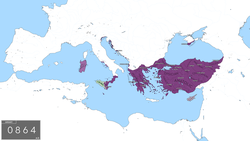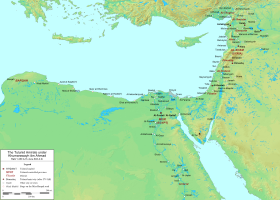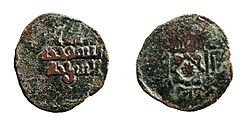884 ⟶ Abdullah ibn Umar al'Habbari Rulers of Sindh
Abdullah ibn Umar al'Habbari (884-913) succeeded his father ...Year
856
884
885
886
888
1301
📜 Appointment of Umar ibn Abd al-Aziz al-Habbari as Governor of Sind and Captive Exchanges
Umar ibn Abd al-Aziz al-Habbari was appointed as Governor of Sind by the Abbasid caliph Al-Mutawakkil. On 23 February 856, there was an exchange of captives with the Byzantine Empire. A second such exchange took place some four years later.⟶

Abbasid CaliphateSindGovernanceDiplomacyByzantine EmpireCaptive ExchangeRegional Politics
 Pakistan
Pakistan Turkey
Turkey👑 Abdullah ibn Umar al'Habbari Rulers of Sindh
Abdullah ibn Umar al'Habbari (884-913) succeeded his father as ruler of Sindh. His father Umar ended up creating a hereditary dynasty in Sindh because of Anarchy at Samarra and Fifth Fitna⟶

SindhHabbari DynastyDynastyGovernanceSuccession880sDecentralizationEarly Islamic Period
 Pakistan
Pakistan India
India👑 Death of Ahmad ibn Tulun and Accession of Khumarawayh
Death of Ahmad ibn Tulun in Egypt, accession of Khumarawayh ibn Ahmad ibn Tulun.⟶

TulunidsLeadership TransitionDeathSuccession880sEgyptAutonomous Rule
 Egypt
Egypt⚰️ Deaths of Umayyad and Habbari Rulers
Death of Muhammad I the Umayyad ruler of Spain, accession of al-Mundhir. Death of Abdullah ibn Umar the Habbari ruler of Sind.⟶

Umayyads of CordobaHabbari DynastyDeathSuccession880sLeadership ChangesEarly Islamic Period
 Spain
Spain Pakistan
Pakistan India
India👑 Death of al-Mundhir and Accession of Abdullah ibn Muhammad
Death of Mundhir the Umayyad ruler of Spain, accession of Abdullah ibn Muhammad al-Umawi.⟶

Umayyads of CordobaDeathSuccession880sIberian PeninsulaLeadership Changes
 Spain
Spain👑 Death of Rukunuddin Kaikaus; Shamsuddin Firoz Shah's Accession
In Bengal, Rukunuddin Kaikaus, the king of Bengal dies and is succeeded by his brother Shamsuddin Firoz Shah.⟶

Bengal SultanateSuccessionLeadershipDynastySouth AsiaGovernance
 Bangladesh
Bangladesh